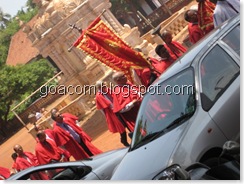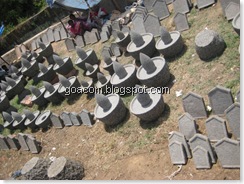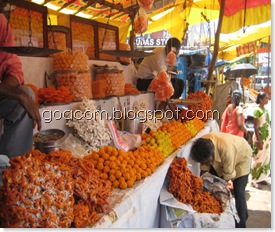One of the major Church feasts in Goa associated with the stocking of provisions for the monsoon season is the feast of the Holy Spirit at the Holy Spirit Church Margao, which is also fondly known all over the state as the "Purumentachem Fest" of Goa.
While there may be many such feasts close to the monsoon season, it is believed that this feast at Margao essentially derived the reputation of being  the original "Purumentachem fest" owing to its closest proximity with the monsoon season in Goa.
the original "Purumentachem fest" owing to its closest proximity with the monsoon season in Goa.
"Purumentachem Fest" a konkani term, could easily be translated into "Feast of Provisions " is a time for people to stock provisions for the monsoons. Although the feast has nothing to do with provisions, the timing of the feast induces a large gravitational pull over the crowds who flock to the fair at this feast to net a good bargain against all kinds of vendors displaying their goods, wares, stocks and harvests. Therefore many items and provisions that do not find their way at other feast fairs in Goa can be spotted at this fair. This peculiarity of certain items being sold only at this May month feast at Margao enticed people visiting the fairs to buy stocks in larger quantities by keeping in mind the upcoming Monsoons. That factor is probably the reason why this feast has derived the strongest bond with the term " Purumentachem Fest"
Salted Fish at the fair in Margao is considered to be the best bargain and people from far and wide within Goa and outside make a special trip to Margao for the feast to help themselves to stock up various varieties of salted fish. Kite fish ( solvve) is a distinct favourite among salt fish shoppers at this market as they are considered the most ideal for a good fish pickle (parra) and would help to pull off with the best meal on a rainy day. Dried prawns are almost a must and can help in making some delicious curry. Also the Bombay ducks in salted form known as the "Sukhe Bombil" have always been considered as a quick appetizer if roasted against the fire. Therefore this feast helps to keep the dying traditions of making nostalgic pickles such as "parra", 'balchao" and "molho" distinctly alive in Goa.
salt fish shoppers at this market as they are considered the most ideal for a good fish pickle (parra) and would help to pull off with the best meal on a rainy day. Dried prawns are almost a must and can help in making some delicious curry. Also the Bombay ducks in salted form known as the "Sukhe Bombil" have always been considered as a quick appetizer if roasted against the fire. Therefore this feast helps to keep the dying traditions of making nostalgic pickles such as "parra", 'balchao" and "molho" distinctly alive in Goa.
Besides the salted fish there is also a sale of traditional harvests of distinct Goan onions and other vegetables which can be stocked for the season. There is the usual fair of the wooden furniture where the traditional carpenters from South Goa display their wares be it beds,sofa sets, tables, benches, stools, showcases , cupboards etc etc. The furniture is known to give the sellers a ready easy market to display and sell their goods while also sourcing new customers for their future supplies.
The Grinding stones such as the flat grinding stone as well as the traditional "Rogddo" are also in full flow at the feast and while one  may think that the electric mixers have taken over the Goan homes, the enthusiasm of these grinding stone traders to market their goods, belies that theory. There seems to be still a distinct lobby in Goa which is wedded to the apparent difference in taste, rendered with the use of the grinding stones and "rogddos' in their day to day requirements for cooking various curries, masalas and sweets in Goa.
may think that the electric mixers have taken over the Goan homes, the enthusiasm of these grinding stone traders to market their goods, belies that theory. There seems to be still a distinct lobby in Goa which is wedded to the apparent difference in taste, rendered with the use of the grinding stones and "rogddos' in their day to day requirements for cooking various curries, masalas and sweets in Goa.
Earthen pots are still ruling the roost in rural as well as urban Goa and the testimony to the fact is the regular return of these breed of traders who faithfully ensure that they occupy a portion of the market square at this Margao feast to show off their traditional wares which need no introductions.The "Kunnem",the "burkulo" the "gurgulet" and the gardening vases get automatic buyers at this festival owing to their traditional attachment and the utility that these earthen wares still command from the "niz goenkar" (true goan) more out of emotional attachment and traditional love than the practical compulsion to use them.
Then there are the other wares such as copper and aluminium vessels, garden tools such as pick axes, choppers, hammers etc. There is also a distinct readymade clothesline on display although most of the clothes at such fairs are of poor quality there is always the enthusiasm of the fair which unquestionably propels the visitors to make frantic buys. Bedsheets and tablecloths besides other cushion materials are also on display and command sizeable crowds in the evenings.
Finally, one cannot miss the "kaddio-boddio", "laddoos" "revddios" and the random open stalls of "festache chonne" ( Grams of the feast) which can be easily spott ed all over the fair with the avid "festakar" ( feast shopper) ensuring that he/she has atleast one pottli of the "kaddio-boddio" and one or two "poll" of the "festache chonne". Without these sweets finding their way into Goan homes, people often consider their visit to the fair as an incomplete one and therefore the traders of these eatables are traditionally known to make brisk business by urging the people to buy some sweets in memory of the feast of the Holy Spirit.
ed all over the fair with the avid "festakar" ( feast shopper) ensuring that he/she has atleast one pottli of the "kaddio-boddio" and one or two "poll" of the "festache chonne". Without these sweets finding their way into Goan homes, people often consider their visit to the fair as an incomplete one and therefore the traders of these eatables are traditionally known to make brisk business by urging the people to buy some sweets in memory of the feast of the Holy Spirit.





No comments:
Post a Comment